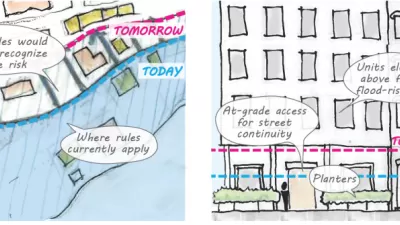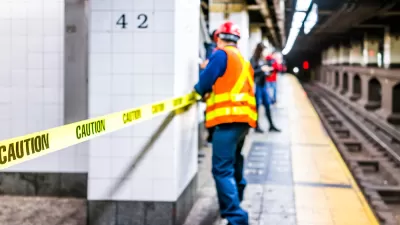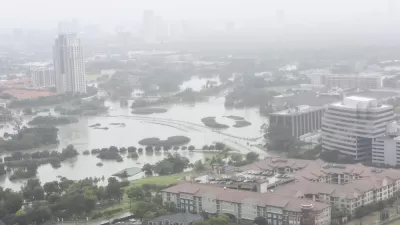Justin Davidson argues that New York's ability to adapt to the effects of climate change will rely on the city learning to embrace nature rather than vainly trying to fight it.
How should New York plan for a more resilient city in the aftermath of Superstorm Sandy? Build massive barriers as Governor Andrew Cuomo and experts have suggested? "Like most cities, New York is built to beat back the sea's spasms
of violence, not to absorb them," says Davidson. But what if, instead, New Yorkers, like Venetians, learn to become comfortable with the occasional flood?
"Imagine, instead, a city that learns to embrace nature rather than
vainly try to fight it," suggests Davidson. "The streets of low-lying areas are paved with
permeable surfaces, allowing floodwaters to seep through rather than
slosh into basements. Tall grasses dance in a spongy buffer zone of
marshland, stretching from the built edge out into the waterways.
Scattered in the Upper Bay are archipelagos of tiny artificial islands
and floating piers - speed bumps for a storm surge. Beneath the waves,
submerged reefs made of old subway cars and oyster beds help diffuse
hard-charging currents, and at the same time host an abundance of marine
life. In that New York, we will watch the sea come in, serenely
confident that it will make an orderly retreat, leaving our vital
systems unmolested and our streets unbesmirched."
FULL STORY: New York’s Wet Future: How the City Could Live With the Sea Rather Than Fighting It

Planetizen Federal Action Tracker
A weekly monitor of how Trump’s orders and actions are impacting planners and planning in America.

Chicago’s Ghost Rails
Just beneath the surface of the modern city lie the remnants of its expansive early 20th-century streetcar system.

San Antonio and Austin are Fusing Into one Massive Megaregion
The region spanning the two central Texas cities is growing fast, posing challenges for local infrastructure and water supplies.

Since Zion's Shuttles Went Electric “The Smog is Gone”
Visitors to Zion National Park can enjoy the canyon via the nation’s first fully electric park shuttle system.

Trump Distributing DOT Safety Funds at 1/10 Rate of Biden
Funds for Safe Streets and other transportation safety and equity programs are being held up by administrative reviews and conflicts with the Trump administration’s priorities.

German Cities Subsidize Taxis for Women Amid Wave of Violence
Free or low-cost taxi rides can help women navigate cities more safely, but critics say the programs don't address the root causes of violence against women.
Urban Design for Planners 1: Software Tools
This six-course series explores essential urban design concepts using open source software and equips planners with the tools they need to participate fully in the urban design process.
Planning for Universal Design
Learn the tools for implementing Universal Design in planning regulations.
planning NEXT
Appalachian Highlands Housing Partners
Mpact (founded as Rail~Volution)
City of Camden Redevelopment Agency
City of Astoria
City of Portland
City of Laramie





























